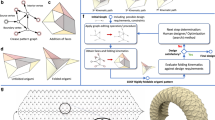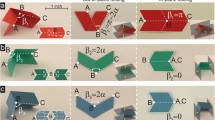Abstract
Foldable shape-changing structures such as origami, deployable, and 4D printed structures have potentials for enhanced packaging, adaptability, and motion capabilities. Distinct geometric features often found in such foldable shape-changing structures include developability and small wall thickness. In this paper, two geometric constraints are introduced to enable the use of density-based topology optimization in designing piecewise developable thin-walled structures. The proposed developability constraint enforces the normal directions of the surfaces of the structures to lie on a prescribed (small) number of input reference planes, which realizes an optimized structure made of piecewise developable surfaces. The proposed thin-wall constraint simultaneously bounds the minimum and the maximum feature sizes in the structures through two PDE-based filtering operations and an aggregation constraint. Several numerical examples demonstrate the effectiveness of the proposed constraints. While the additional constraints inevitably compromise the structural performance, the ability to control the desired geometric features in topology optimization would benefit the rapidly growing field of foldable shape-changing structures.

















Similar content being viewed by others
References
Aumann G (2004) Degree elevation and developable Bézier surfaces. Comput Aided Geom Des 21:661
Bendsoe MP, Sigmund O (2003) Topology optimization: theory, methods, and applications. Springer Science & Business Media, New York
Bruns TE, Tortorelli DA (2001) Topology optimization of non-linear elastic structures and compliant mechanisms. Comput Methods Appl Mech Eng 190:3443
Carstensen JV, Guest JK (2018) Projection-based two-phase minimum and maximum length scale control in topology optimization. In: Structural and multidisciplinary optimization, pp 1–16
Chu C-H, Séquin CH (2002) Developable Bézier patches: properties and design. Comput Aided Des 34:511
Clausen A, Aage N, Sigmund O (2015) Topology optimization of coated structures and material interface problems. Comput Methods Appl Mech Eng 290:524
Clausen A, Andreassen E, Sigmund O (2015) Topology optimization for coated structures. In: Li Q, Steven GP, Zhang Z (eds) Proceedings of the 11th world congress on structural and multidisciplinary optimization, pp 7–12
Cozmei M, Hasseler T, Kinyon E, Wallace R, Deleo AA, Salviato M (2020) Aerogami: composite origami structures as active aerodynamic control. Compos B Eng 184:107719
Deleo AA, O’Neil J, Yasuda H, Salviato M, Yang J (2020) Origami-based deployable structures made of carbon fiber reinforced polymer composites. Compos Sci Technol 191:108060
Dienemann R, Schumacher A, Fiebig S (2017) Topology optimization for finding shell structures manufactured by deep drawing. Struct Multidisc Optim 56:473
Elber G (1995) Model fabrication using surface layout projection. Comput Aided Des 27:283
Fernández E, Collet M, Alarcón P, Bauduin S, Duysinx P (2019) An aggregation strategy of maximum size constraints in density-based topology optimization. Struct Multidisc Optim 60:2113
Goldman R (2005) Curvature formulas for implicit curves and surfaces. Comput Aided Geom Des 22:632
Guest JK (2009) Imposing maximum length scale in topology optimization. Struct Multidisc Optim 37:463
Guest JK, Prévost JH, Belytschko T (2004) Achieving minimum length scale in topology optimization using nodal design variables and projection functions. Int J Numer Meth Eng 61:238
Hoschek J (1998) Approximation of surfaces of revolution by developable surfaces. Comput Aided Des 30:757
Ion A, Rabinovich M, Herholz P, Sorkine-Hornung O (2020) Shape approximation by developable wrapping. ACM Trans Graph (TOG) 39:1
Jiang C, Wang C, Rist F, Wallner J, Pottmann H (2020) Quad-mesh based isometric mappings and developable surfaces. ACM Trans Graph (TOG) 39:128
Julius D, Kraevoy V, Sheffer A (2005) D-charts: quasi-developable mesh segmentation. Comput Graph Forum 24:581
Kawamoto A, Matsumori T, Yamasaki S, Nomura T, Kondoh T, Nishiwaki S (2011) Heaviside projection based topology optimization by a PDE-filtered scalar function. Struct Multidisc Optim 44:19
Kilian M, Flöry S, Chen Z, Mitra NJ, Sheffer A, Pottmann H (2008) Curved folding. ACM Trans Graph 27:75
Kühnel W (2015) Differential geometry, vol 77. American Mathematical Soc, New York
Laccone F, Malomo L, Pietroni N, Cignoni P, Schork T (2021) Integrated computational framework for the design and fabrication of bending-active structures made from flat sheet material. Structures 34:979–994
Lang J, Röschel O (1992) Developable (1, n)-Bézier surfaces. Comput Aided Geom Des 9:291
Lazarov BS, Sigmund O (2011) Filters in topology optimization based on Helmholtz-type differential equations. Int J Numer Method Eng 86:765
Lazarov BS, Wang F (2017) Maximum length scale in density based topology optimization. Comput Methods Appl Mech Eng 318:826
Liu Y, Pottmann H, Wallner J, Yang Y-L, Wang W (2006) Geometric modeling with conical meshes and developable surfaces. ACM Trans Graph 25:681
Massarwi F, Elber G, Gotsman C (2007) Papercraft models using generalized cylinders. In: Computer graphics and applications, pacific conference on (PG) (IEEE), pp 148–157
Mitani J, Suzuki H (2004) Making papercraft toys from meshes using strip-based approximate unfolding. ACM Trans Graph 23:259
Niu B, Wadbro E (2019) On equal-width length-scale control in topology optimization. Struct Multidisc Optim 59:1321
Nomura T, Kawamoto A, Kondoh T, Dede EM, Lee J, Song Y, Kikuchi N (2019) Inverse design of structure and fiber orientation by means of topology optimization with tensor field variables. Compos B Eng 176:107187
Pottmann H, Schiftner A, Bo P, Schmiedhofer H, Wang W, Baldassini N, Wallner J (2008) Freeform surfaces from single curved panels. ACM Trans Graph 27:76
Pottmann H, Farin G (1995) Developable rational Bézier and B-spline surfaces. Comput Aided Geom Des 12:513
Poulsen TA (2003) A new scheme for imposing a minimum length scale in topology optimization. Int J Numer Meth Eng 57:741
Pérez F, Suárez JA (2007) Quasi-developable B-spline surfaces in ship hull design. Comput Aided Des 39:853
Rabinovich M, Hoffmann T, Sorkine-Hornung O (2018) Discrete geodesic nets for modeling developable surfaces. ACM Trans Graph (ToG) 37:1
Redoutey M, Roy A, Filipov ET (2021) Pop-up kirigami for stiff, dome-like structures. Int J Solids Struct 229:111140
Rose K, Sheffer A, Wither J, Cani M-P, Thibert B (2007) Developable surfaces from arbitrary sketched boundaries. In: SGP’07-5th Eurographics symposium on geometry processing (Eurographics Association), pp 163–172
Shatz I, Tal A, Leifman G (2006) Paper craft models from meshes. Vis Comput 22:825
Sigmund O (1997) On the design of compliant mechanisms using topology optimization. J Struct Mech 25:493
Sigmund O (2007) Morphology-based black and white filters for topology optimization. Struct Multidisc Optim 33:401
Solomon J, Vouga E, Wardetzky M, Grinspun E (2012) Flexible developable surfaces. Comput Graph Forum 31:1567
Stein O, Grinspun E, Crane K (2018) Developability of triangle meshes. ACM Trans Graph 37:77
Svanberg K (1987) The method of moving asymptotes-a new method for structural optimization. Int J Numer Method Eng 24:359
Tahouni Y, Cheng T, Wood D, Sachse R, Thierer R, Bischoff M, Menges A (2020) Self-shaping curved folding: A 4D-printing method for fabrication of self-folding curved crease structures. In: Symposium on computational fabrication, pp 1–11
Tang C, Bo P, Wallner J, Pottmann H (2016) Interactive design of developable surfaces. ACM Trans Graph 35:12
Träff EA, Sigmund O, Aage N (2021) Topology optimization of ultra high resolution shell structures. Thin Walled Struct 160:107349
Wang C, Qian X (2018) Heaviside projection-based aggregation in stress-constrained topology optimization. Int J Numer Meth Eng 115:849
Wu J, Aage N, Westermann R, Sigmund O (2018) Infill optimization for additive manufacturing-approaching bone-like porous structures. IEEE Trans Visual Comput Graphics 24:1127
Wu J, Clausen A, Sigmund O (2017) Minimum compliance topology optimization of shell-infill composites for additive manufacturing. Comput Methods Appl Mech Eng 326:358
Zhang S, Gain AL, Norato JA (2017) Stress-based topology optimization with discrete geometric components. Comput Methods Appl Mech Eng 325:1
Zhang S, Gain AL, Norato JA (2018) A geometry projection method for the topology optimization of curved plate structures with placement bounds. Int J Numer Meth Eng 114:128
Zhang S, Norato JA, Gain AL, Lyu N (2016) A geometry projection method for the topology optimization of plate structures. Struct Multidisc Optim 54:1173
Zhang W, Zhong W, Guo X (2014) An explicit length scale control approach in SIMP-based topology optimization. Comput Methods Appl Mech Eng 282:71
Zhou M, Lazarov BS, Wang F, Sigmund O (2015) Minimum length scale in topology optimization by geometric constraints. Comput Methods Appl Mech Eng 293:266
Zhou Y, Nomura T, Saitou K (2021) Anisotropic multicomponent topology optimization for additive manufacturing with build orientation design and stress-constrained interfaces. J Comput Inform Sci Eng 21:011007
Author information
Authors and Affiliations
Corresponding author
Ethics declarations
Conflict of interest
The authors have no conflict of interest in the preparation or publication of this work.
Replication of Results
Due to institutional constraints, the source code is unavailable. However, further algorithm details are available upon request to the authors.
Additional information
Responsible Editor: Qing Li
Publisher's Note
Springer Nature remains neutral with regard to jurisdictional claims in published maps and institutional affiliations.
Rights and permissions
About this article
Cite this article
Zhou, Y., Nomura, T., Dede, E.M. et al. Topology optimization with wall thickness and piecewise developability constraints for foldable shape-changing structures. Struct Multidisc Optim 65, 118 (2022). https://doi.org/10.1007/s00158-022-03219-8
Received:
Revised:
Accepted:
Published:
DOI: https://doi.org/10.1007/s00158-022-03219-8




